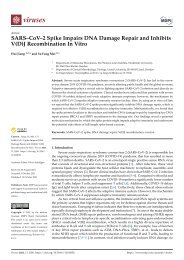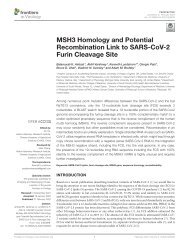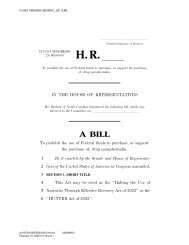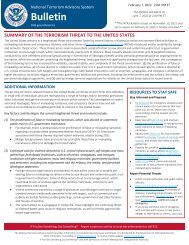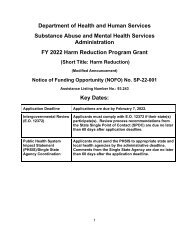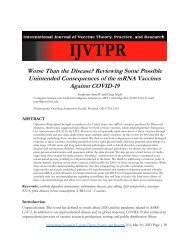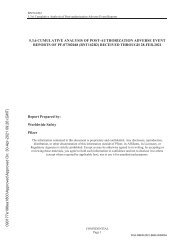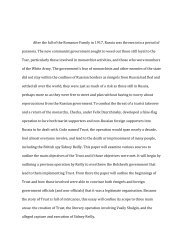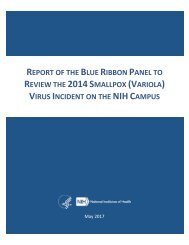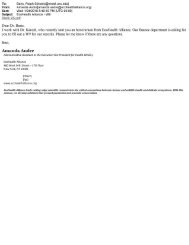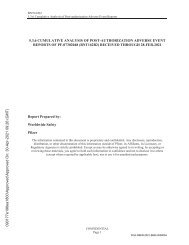A Literature Review and Meta Analysis of the Effects of Lockdowns on COVID 19 Mortality
Create successful ePaper yourself
Turn your PDF publications into a flip-book with our unique Google optimized e-Paper software.
crucial which may have affected <str<strong>on</strong>g>the</str<strong>on</strong>g> quality <str<strong>on</strong>g>of</str<strong>on</strong>g> <str<strong>on</strong>g>the</str<strong>on</strong>g> papers. Including <str<strong>on</strong>g>the</str<strong>on</strong>g>m makes it possible to<br />
compare <str<strong>on</strong>g>the</str<strong>on</strong>g> results <str<strong>on</strong>g>of</str<strong>on</strong>g> early studies to studies carried out at a later stage. 20<br />
The role <str<strong>on</strong>g>of</str<strong>on</strong>g> optimal timing<br />
We exclude papers which analyze <str<strong>on</strong>g>the</str<strong>on</strong>g> effect <str<strong>on</strong>g>of</str<strong>on</strong>g> early lockdowns in c<strong>on</strong>trast to later lockdowns.<br />
There’s no doubt that being prepared for a p<str<strong>on</strong>g>and</str<strong>on</strong>g>emic <str<strong>on</strong>g>and</str<strong>on</strong>g> knowing when it arrives at your<br />
doorstep is vital. However, at least two problems arise with respect to evaluating <str<strong>on</strong>g>the</str<strong>on</strong>g> effect <str<strong>on</strong>g>of</str<strong>on</strong>g><br />
well-timed lockdowns.<br />
First, when <strong>COVID</strong>-<strong>19</strong> hit Europe <str<strong>on</strong>g>and</str<strong>on</strong>g> <str<strong>on</strong>g>the</str<strong>on</strong>g> United States, it was virtually impossible to determine<br />
<str<strong>on</strong>g>the</str<strong>on</strong>g> right timing. The World Health Organizati<strong>on</strong> declared <str<strong>on</strong>g>the</str<strong>on</strong>g> outbreak a p<str<strong>on</strong>g>and</str<strong>on</strong>g>emic <strong>on</strong> March 11,<br />
2020, but at that date, Italy had already registered 13.7 <strong>COVID</strong>-<strong>19</strong> deaths per milli<strong>on</strong>. On March<br />
29, 2020, 18 days after <str<strong>on</strong>g>the</str<strong>on</strong>g> WHO declared <str<strong>on</strong>g>the</str<strong>on</strong>g> outbreak a p<str<strong>on</strong>g>and</str<strong>on</strong>g>emic <str<strong>on</strong>g>and</str<strong>on</strong>g> <str<strong>on</strong>g>the</str<strong>on</strong>g> earliest a lockdown<br />
resp<strong>on</strong>se to <str<strong>on</strong>g>the</str<strong>on</strong>g> WHO’s announcement could potentially have an effect, <str<strong>on</strong>g>the</str<strong>on</strong>g> mortality rate in Italy<br />
was a staggering 178 <strong>COVID</strong>-<strong>19</strong> deaths per milli<strong>on</strong> with an additi<strong>on</strong>al 13 per milli<strong>on</strong> dying each<br />
day. 21<br />
Sec<strong>on</strong>dly, it is extremely difficult to differentiate between <str<strong>on</strong>g>the</str<strong>on</strong>g> effect <str<strong>on</strong>g>of</str<strong>on</strong>g> public awareness <str<strong>on</strong>g>and</str<strong>on</strong>g> <str<strong>on</strong>g>the</str<strong>on</strong>g><br />
effect <str<strong>on</strong>g>of</str<strong>on</strong>g> lockdowns when looking at timing because people <str<strong>on</strong>g>and</str<strong>on</strong>g> politicians are likely to react to<br />
<str<strong>on</strong>g>the</str<strong>on</strong>g> same informati<strong>on</strong>. As Figure 4 illustrates, all European countries <str<strong>on</strong>g>and</str<strong>on</strong>g> U.S. states that were hit<br />
hard <str<strong>on</strong>g>and</str<strong>on</strong>g> early by <strong>COVID</strong>-<strong>19</strong> experienced high mortality rates, whereas all countries hit<br />
relatively late experienced low mortality rates. Björk et al. (2021) illustrate <str<strong>on</strong>g>the</str<strong>on</strong>g> difficulties in<br />
analyzing <str<strong>on</strong>g>the</str<strong>on</strong>g> effect <str<strong>on</strong>g>of</str<strong>on</strong>g> timing. They find that a 10-stringency-points-stricter lockdown would<br />
reduce <strong>COVID</strong>-<strong>19</strong> mortality by a total <str<strong>on</strong>g>of</str<strong>on</strong>g> 200 deaths per milli<strong>on</strong> 22 if d<strong>on</strong>e in week 11, 2020, but<br />
would <strong>on</strong>ly have approximately 1/3 <str<strong>on</strong>g>of</str<strong>on</strong>g> <str<strong>on</strong>g>the</str<strong>on</strong>g> effect if implemented <strong>on</strong>e week earlier or later <str<strong>on</strong>g>and</str<strong>on</strong>g> no<br />
effect if implemented three weeks earlier or later. One interpretati<strong>on</strong> <str<strong>on</strong>g>of</str<strong>on</strong>g> this result is that<br />
lockdowns do not work if people ei<str<strong>on</strong>g>the</str<strong>on</strong>g>r find <str<strong>on</strong>g>the</str<strong>on</strong>g>m unnecessary <str<strong>on</strong>g>and</str<strong>on</strong>g> fail to obey <str<strong>on</strong>g>the</str<strong>on</strong>g> m<str<strong>on</strong>g>and</str<strong>on</strong>g>ates or if<br />
people voluntarily lock <str<strong>on</strong>g>the</str<strong>on</strong>g>mselves down. This is <str<strong>on</strong>g>the</str<strong>on</strong>g> argument Allen (2021) uses for <str<strong>on</strong>g>the</str<strong>on</strong>g><br />
ineffectiveness <str<strong>on</strong>g>of</str<strong>on</strong>g> <str<strong>on</strong>g>the</str<strong>on</strong>g> lockdowns he identifies. If this interpretati<strong>on</strong> is true, what Björk et al.<br />
(2021) find is that informati<strong>on</strong> <str<strong>on</strong>g>and</str<strong>on</strong>g> signaling is far more important than <str<strong>on</strong>g>the</str<strong>on</strong>g> strictness <str<strong>on</strong>g>of</str<strong>on</strong>g> <str<strong>on</strong>g>the</str<strong>on</strong>g><br />
lockdown. There may be o<str<strong>on</strong>g>the</str<strong>on</strong>g>r interpretati<strong>on</strong>s, but <str<strong>on</strong>g>the</str<strong>on</strong>g> point is that studies focusing <strong>on</strong> timing<br />
cannot differentiate between <str<strong>on</strong>g>the</str<strong>on</strong>g>se interpretati<strong>on</strong>s. However, if lockdowns have a notable effect,<br />
we should see this effect regardless <str<strong>on</strong>g>of</str<strong>on</strong>g> <str<strong>on</strong>g>the</str<strong>on</strong>g> timing, <str<strong>on</strong>g>and</str<strong>on</strong>g> we should identify this effect more<br />
correctly by excluding studies that exclusively analyze timing.<br />
20<br />
We also intended to exclude studies which were primarily based <strong>on</strong> data from 2021 (as <str<strong>on</strong>g>the</str<strong>on</strong>g>se studies would be<br />
heavily affected by vaccines) <str<strong>on</strong>g>and</str<strong>on</strong>g> studies that did not cover at least <strong>on</strong>e EU-country, <str<strong>on</strong>g>the</str<strong>on</strong>g> United States, <strong>on</strong>e U.S.<br />
U.S. state or Latin America, <str<strong>on</strong>g>and</str<strong>on</strong>g> where at least <strong>on</strong>e country/state was not an isl<str<strong>on</strong>g>and</str<strong>on</strong>g>. However, we did not find any<br />
such studies.<br />
21<br />
There’s approximately a two-to-four-week gap between infecti<strong>on</strong> <str<strong>on</strong>g>and</str<strong>on</strong>g> deaths. See footnote 29.<br />
22<br />
They estimate that 10-point higher stringency will reduce excess mortality by 20 “per week <str<strong>on</strong>g>and</str<strong>on</strong>g> milli<strong>on</strong>” in <str<strong>on</strong>g>the</str<strong>on</strong>g> 10<br />
weeks from week 14 to week 23.<br />
11




